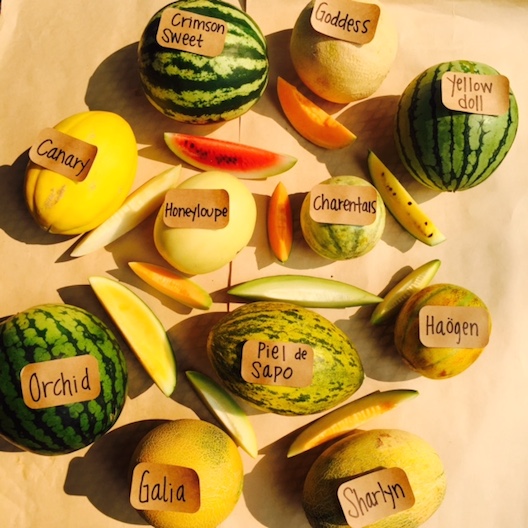Recently one of our members wrote to us saying, “I only know the names of Cantaloupe, Honeydew and Watermelon. We get SO MANY MORE than that. I would really like to know more about them.”
Full Belly doesn’t grow the standard cantaloupe. We are focussed more on specialty melons. For example, in terms of orange-fleshed melons, some of our varieties are Goddess (a lot like the better-known Ambrosia), Charentais (a French, wonderfully aromatic cantaloupe with smooth skin), Honeyloupe (a cross between Honeydew and Cantaloupe) and San Juan (a bit larger than the others, football-shaped.) Some of these melons are “netted” – with rough skin (Goddess and San Juan) and others are smooth-skinned (Charentais and Honeyloupe). We also grow melons with green flesh like the Galia (netted) and Haogan (not netted). Both of these green-fleshed melons are sweet and juicy, with tropical flavor notes. The Haogan is an heirloom variety with an amazing spicy aroma and an unusual tropical flavor, but it doesn’t ship well and thus only goes to our farmers markets.

These melons can all ripen off the vine, but we pick them ripe and full-flavored by looking at their color in the field. All of these melons have to be picked once they are ripe, regardless of how many melon orders we have in the works. Managing the availability of 12 or 14 different melon and watermelon varieties can be pretty tricky. During the week, each day may bring a different melon going into your CSA box, which is why we don’t usually tell you the variety — there can be more than one, even in one day!
I think most of you have had the Sharlyn in your boxes this year — it is a favorite here, oblong shape with netted skin, whitish flesh and a pink band around the seeds when it is ripe to perfection. Another one that has done well this year is the Piel de Sapo. Like the Sharlyn, it is a creamy-fleshed melon, but with some tropical flavor hints. The Piel stores well (it has a thick skin and doesn’t give off a lot of aroma) and is also known as the Santa Claus melon. Piel de Sapo translates from the Spanish as “toad skin.” The skin is green with deep green stripes and yellow spots. It’s related to the Canary melon — both of them store well and even get sweeter with a few weeks off the vine.
Full Belly has been growing melons and watermelons for 30 years, and we constantly try new varieties, changing the mix, striving to find melons that grow well here and taste delicious. We always try to make the melon season last as long as possible. In the spring, to get a jump on the season, we transplant baby plants into the cold soil, cover the soil with black plastic, and then cover the beds with row-cover, creating a warm protected space for the plants. If we plant melon seeds early in the season, it can be a bit dicey because unless the soil is consistently above 60-degrees, the seeds don’t germinate well — so it is only the later fields that are direct seeded. This summer, in addition to two transplanted fields, we had eight successive additional direct-seeded plantings. Depending on the weather, we could have melons through mid-October!
–Judith Redmond
